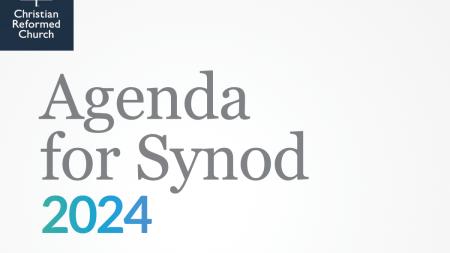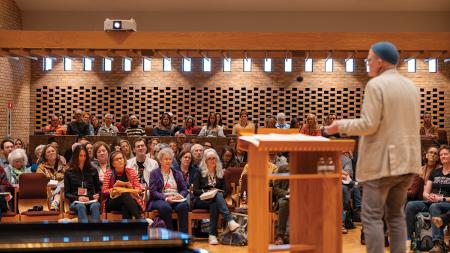Binational Church Issues Explained

Earlier this year, the Canada Corporation of the Christian Reformed Church in North America (CRCNA) sent a letter to churches announcing upcoming changes to the structure and leadership of the Canadian side of the binational church.
In an attempt to understand the restructuring process currently under way and to discuss some of the related concerns of members of the CRC in Canada, the Christian Courier’s editor interviewed Darren Roorda, director of Canadian Ministries, and Andy DeRuyter, board chair of the Canada Corporation, on May 28. The following conversation has been edited for clarity and length.
CC: If you could boil it down, how would you explain what’s happened since January?
Andy DeRuyter: The Canadian board, which is part of the Council of Delegates (COD), found that there were some things that needed to be altered to make us more compliant as a non-profit. So we [discussed] direction and control, budgeting, who’s making decisions, and how Canadian money is spent in Canadian ministries, and then we needed to get some legal advice and found out that we had to make some pretty significant changes in how we govern ourselves. Now we’re rebuilding and putting all the pieces back together.
Darren Roorda: The board acted, as boards are meant to do by federal law and ecclesiastical principle and desire, in a protective way for its key stakeholders – the constituency of the CRC.
CC: Can you clarify who “Canada Corp.” is?
DeRuyter: In order to act as a non-profit in Canada, you have to set yourself up as a corporation. This was done several years ago. The two corporations have taken on a bigger role in the past two years because of changes in government regulations, mostly on the Canadian side. Canada’s laws for non-profits are more intense. [Canada Corp.] is made up of people that are elected by each classis to serve; each classis has its own representative. It is a group that runs things in the background.
Roorda: People are asking “What’s Canada Corp.? Can’t we do church with one board, predominantly populated by U.S. citizens?” The government says, “No, you can’t.” It’s against the law to have a board that’s not in control of its own affairs.
DeRuyter: When everything is running smoothly in the background, nobody asks questions. But when there are major changes, people say – “Who is this board? Who are these people?” This is a group of people that synod sanctioned to represent the Canadian and American church in their own contexts.
CC: Some people are worried that this will expand the CRC’s institutional footprint.
Roorda: The exact opposite. If you think the best way to run an operation is to do the exact same thing as your partner across the border, then, yes, it’s a duplication. But if you think that both sides of the border have the opportunity to tailor ministry so that it fits your context, any number of differences could happen. You could drop your staff in half, you could multiply them by two in order to achieve a better result in a new area of ministry. We’re discussing efficiency and effectiveness. If this last year is any example, I can tell you that without any increase in staffing or salary, we’ve been able to gain staff-directive level oversight in a way that meets all regulations for compliance. It doesn’t have to be a duplication.
CC: What can you tell me about the Canadian Restructuring Team?
Roorda: We’re putting together a group of 8-10 people representing local churches, ministries of the CRCNA, [and] classes to discern what is the most effective structure and means by which the Canadian side of the church should conduct itself in ministry moving forward, given that federal government expects us to have direction and control, overseen by Canadian leaders. We have pastors, laypeople, CRC staff, directors, [and] classis reps, and we’re producing a draft report in the fall.
CC: Could Synod 2021 veto the restructuring plan that comes from that report?
DeRuyter: Synod has control of the ecclesial matters. What the laws are in both countries we simply have to follow. I would ask the question back, could synod tell either the Canadian or American church to do something illegal?
CC: No, definitely not.
DeRuyter: All we’re going to do is make the administrative side and governance side compliant. Can synod say no? I don’t see why they would. I’m sure there’ll be a lot of discussion because people don’t really understand what happened and the speed [with which] it happened, and there [are] reasons for that.
CC: It feels a bit disingenuous to refer to this as “only changes to a specific legal problem” because even though it’s still unclear what all the implications will be, they feel big. Can you speak to that?
Roorda: If you want to say it’s “only a legal thing,” you have the impression that you can tick off a box, do one or two legal things in the context of a board, and you’re all fine. But this issue – meeting federal intentions – relates to a matter that is bigger than just ensuring the minutes are signed. It relates to the behavior of the governing bodies, the people in ministry, the institution or charity that is formed. Yes, it is a big deal; it will mean more changes over time, and so it is a legal thing; but because of the nature of the legal thing it will have more and more changes over time. We shouldn’t be afraid of that or be afraid that we’re divorcing ourselves from the U.S. church. It can be all three of those things at the same time. It’s not either/or.
CC: What do you say to concerns this will lead to a Canada/U.S. split?
Roorda: For someone to surmise that separation is inevitable demonstrates that they are unaware of our very own CRC history and success of the exercise of this matter via the precedent already set in CRC circles. World Renew has been exercising the same level of compliance in similar ways, and their unity and partnership remain high.
CC: Instead of “independence,” then, how would you characterize the changes?
Roorda: Highly collaborative interdependent self-determination. Call it a marriage with two equal partners.
CC: What is happening this summer on the work of restructuring?
DeRuyter: There are three parts – basically the skeleton model that was approved is that each corporation [U.S. and Canadian] will have its own executive director and each corporation is formulating a job description. These two directors will work together along with a third position that synod is going to be quite involved with, an ecclesiastical officer that will tie the two executive directors together, so that we can remain one denomination on both sides of the border. We’ve approved a skeleton, and now over the summer months we’re putting meat on that, and [we] can come to the COD in October and start making some good headway to eventually get this in front of Synod 2021.
Roorda: I would speak about it more philosophically. This whole thing is not about whether or not we are in a relationship with the U.S. We are in a relationship with the U.S. churches and staff and every entity of the CRCNA. This is a question about how we are in relationship. Moving forward, I’ve got two “C” words – contextualization and collaboration: to do ministry in such a highly relevant way that it is appropriate contextually to the Canadian audience, [and] collaboration with U.S. partners, churches, and ministries in such a way that the contextual ministry that we’re doing is maximized. This kind of partnership is fantastic. We live in a Christian missional environment where we have to believe that we can’t do things on our own but have to be collaborative within the CRC and outside, ecumenically. That to me is the exciting next chapter.
This article first appeared in the Christian Courier and was reprinted with permission.


